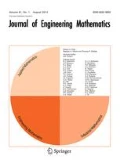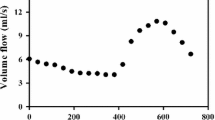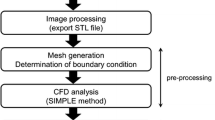Abstract
Detailed knowledge of the hemodynamic conditions in normal cerebral arteries is important for a better understanding of the underlying mechanisms leading to the initiation and progression of cerebrovascular diseases. Information about the baseline values of hemodynamic variables such as wall shear stresses is necessary for comparison to pathological conditions such as in cerebral aneurysms or arterial stenoses. The purpose of this study was to compare the blood-flow patterns in cerebral arteries of normal subjects determined by 4D phase-contrast magnetic resonance and image-based computational fluid-dynamics techniques in order to assess their consistency and to highlight their differences. The goal was not to validate (or disprove) any of the two methodologies but rather to identify regions where disagreements are to be expected and to provide guidance when interpreting the data produced by each technique.
Similar content being viewed by others
References
Weir B (2002) Unruptured intracranial aneurysms: a review. J Neurosurg 96: 3–42
Stehbens WE (1972) Intracranial aneurysms. In: Pathology of the cerebral blood vessels. pp 351–470
Foutrakis GN, Yonas H, Sclabassi RJ (1999) Saccular aneurysm formation in curved and bifurcation arteries. AJNR Am J Neuroradiol 20: 1309–1317
Kayembe KNT, Sasahara M, Hazama F (1984) Cerebral aneurysms and variations of the circle of Willis. Stroke 15: 846–850
Tateshima S, Murayama Y, Villablanca JP (2001) Intraaneurysmal flow dynamics study featuring an acrylic aneurysm model manufactured using computerized tomography angiogram as a mold. J Neurosurg 95(6): 1020–1027
Hirabayashi M, Ohta M, Rufenacht DA (2003) Characterization of flow reduction properties in an aneurysm due to a stent. Phys Rev E Stat Nonlinear Soft Matter Phys 68(2): 0219918. doi:10.1103/PhysRevE.68.021918
Shojima M, Oshima M, Takagi K, Torii R, Hayakawa M, Katada K, Morita A, Kirino T (2004) Magnitude and role of wall shear stress on cerebral aneurysm: computational fluid dynamic study of 20 middle cerebral artery aneurysms. Stroke 35(11): 2500–2505. doi:10.1161/01.STR.0000144648.89172.0f
Cebral JR, Castro MA, Burgess JE, Pergolizzi R, Sheridan MJ, Putman CM (2005) Characterization of cerebral aneurysm for assessing risk of rupture using patient-specific computational hemodynamics models. AJNR Am J Neuroradiol 26: 2550–2559
Steinman DA, Milner JS, Norley CJ, Lownie SP, Holdworth DW (2003) Image-based computational simulation of flow dynamics in a giant intracranial aneurysm. AJNR Am J Neuroradiol 24(4): 559–566
Jou LD, Quick CM, Young WL, Lawton MT, Higashida R, Martin A, Saloner D (2003) Computational approach to quantifying hemodynamic forces in giant cerebral aneurysms. AJNR Am J Neuroradiol 24(9): 1804–1810
Ferrandez A, David T, Bamford J, Scott J, Guthrie A (2000) Computational models of blood flow in the circle of Willis. Comput Methods Biomech Biomed Eng 4: 1–26. doi:10.1080/10255840008907996
Cebral JR, Castro MA, Soto O, Löhner R, Alperin N (2003) Blood flow models of the circle of Willis from magnetic resonance data. J Eng Math 47(3–4): 369–386. doi:10.1023/B:ENGI.0000007977.02652.02
Alnaes MS, Isaksen J, Mardal KE, Rommer B, Morgan MK, Ingebritsen T (2007) Computation of hemodynamics in the circle of Willis. Stroke 38: 2500–2505. doi:10.1161/STROKEAHA.107.482471
Calamante F, Yim PJ, Cebral JR (2003) Estimation of bolus dispersion effects in perfusion MRI using image-based computational fluid dynamics. Neuroimage 19: 342–352. doi:10.1016/S1053-8119(03)00090-9
Bammer R, Hope TA, Aksoy M, Alley MT (2007) Time-resolved 3D quantitative flow MRI of the major intracranial vessels: initial experience and comparative evaluation at 1.5T and 3.0T in combination with parallel imaging. Magn Reson Med 57: 127–140. doi:10.1002/mrm.21109
Wetzel S, Meckel S, Frydrychowicz A, Bonati L, Radue EW, Scheffler K, Hennig J, Markl M (2007) In vivo assessment and visualization of intracranial arterial hemodynamics with flow-sensitized 4D MR imaging at 3T. AJNR Am J Neuroradiol 28: 433–438
Yim PJ, Boudewijn G, Vasbinder B, Ho VB, Choyke PL (2003) Isosurfaces as deformable models for magnetic resonance angiography. IEEE Trans Med Imaging 22(7): 875–881. doi:10.1109/TMI.2003.815056
Yim PJ, Cebral JR, Mullick R, Choyke PL (2001) Vessel surface reconstruction with a tubular deformable model. IEEE Trans Med Imaging 20(12): 1411–1421. doi:10.1109/42.974935
Cebral JR, Löhner R, Choyke PL, Yim PJ (2001) Merging of intersecting triangulations for finite element modeling. J Biomech 34: 815–819. doi:10.1016/S0021-9290(01)00018-5
Taubin G (1995) A signal processing approach to fair surface design. In: Proceedings of 22nd annual conference on computer graphics and interactive techniques (SIGGRAPH 1995). Los Angeles, CA, 6–11 Aug
Löhner R (1997) Automatic unstructured grid generators. Finite Elem Anal Des 25: 111–134. doi:10.1016/S0168-874X(96)00038-8
Alperin N, Lee SH (2003) PUBS: pulsatility-based segmentation of lumens conducting non-steady flow. Magn Reson Med 49: 934–944. doi:10.1002/mrm.10455
Taylor CA, Hughes TJR, Zarins CK (1998) Finite element modeling of blood flow in arteries. Comput Methods Appl Mech Eng 158: 155–196. doi:10.1016/S0045-7825(98)80008-X
Cebral JR, Castro MA, Appanaboyina S, Putman CM, Millan D, Frangi AF (2005) Efficient pipeline for image-based patient- specific analysis of cerebral aneurysm hemodynamics: technique and sensitivity. IEEE Trans Med Imaging 24(1): 457–467. doi:10.1109/TMI.2005.844159
Cebral JR, Löhner R, Appanaboyina S, Putman CM (2007) Image-based computational hemodynamics methods and their application for the analysis of blood flow past endovascular devices. In: Leondes CT (ed) Biomechanical systems technology: (1) Computational methods. World Scientific, pp 29–85
Press WH, Flanney BP, Teukolsky SA, Vetterling WT (1992) Numerical recipes C: the art of scientific computing. Cambridge University Press, New York
Löhner R (1995) Robust, vectorized search algorithms for interpolation on unstructured grids. J Comput Phys 118: 380–387. doi:10.1006/jcph.1995.1107
Löhner R, Appanaboyina S, Cebral JR (2007) Parabolic recovery of boundary gradients. Commun Numer Methods Eng doi:10.1002/cnm.1054
Box FMA, Vander Geest RJ, Vander Grond J, Van Osch MJP, Zwinderman AH, Palm-Meinders IH, Doornbos J, Blauw GJ, Van Buchem MA, Reiber JH (2007) Reproducibility of wall shear stress assessment with the paraboloid method in the internal carotid artery with velocity encoded MRI in healthy young individuals. J Magn Reson Imaging 26: 598–605. doi:10.1002/jmri.21086
Author information
Authors and Affiliations
Corresponding author
Rights and permissions
About this article
Cite this article
Cebral, J.R., Putman, C.M., Alley, M.T. et al. Hemodynamics in normal cerebral arteries: qualitative comparison of 4D phase-contrast magnetic resonance and image-based computational fluid dynamics. J Eng Math 64, 367–378 (2009). https://doi.org/10.1007/s10665-009-9266-2
Received:
Accepted:
Published:
Issue Date:
DOI: https://doi.org/10.1007/s10665-009-9266-2




